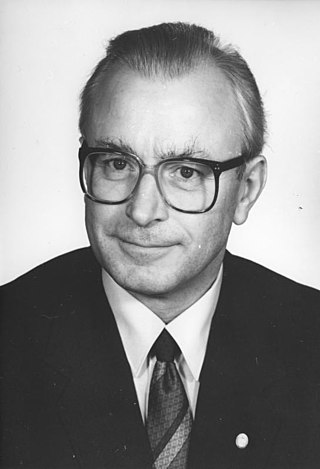Related Research Articles

Friedrich Wilhelm Reinhold Pieck was a German communist politician who served as the chairman of the Socialist Unity Party from 1946 to 1950 and as president of the German Democratic Republic from 1949 to 1960.

Wolfgang Schwanitz was a German intelligence official, who was the last head of the Stasi, the East German secret police. It was officially renamed the "Office for National Security" on 17 November 1989. Unlike his predecessor, Erich Mielke, he did not hold the title "Minister of State Security", but held the title of "Leader of the Office for National Security". Following the German reunification, he was active as an author of works that sought to portray the Stasi in a positive light.
Friedrich Wilhelm Beuttel was a German communist and resistance fighter against Nazism.
Andreas Herbst is a German historian. His career has been divided between authorship and museum work. He has written extensively on aspects of the German Democratic Republic and since 2001 has worked for the German Resistance Memorial Center in Berlin.
Hermann Weber was a German historian and political scientist. He has been described as "the man who knew everything about the German Democratic Republic".
Manfred Döring was a former Major general (Generalmajor) with the East German Ministry for State Security (Stasi). He also served, between 1987 and 1990, as a commander of the elite motorised rifles regiment, the Felix Dzerzhinsky Guards.
Ehrhart Neubert is a retired German Evangelical minister and theologian.
Luise Kraushaar was a German political activist who became a Resistance campaigner against National Socialism and who also, after she left Germany, worked in the French Resistance. She later became a historian, employed at Berlin's Marxism–Leninism Institute in the German Democratic Republic.
Emmi Handke was a German Communist party activist.
Marlies Deneke is a German politician.
Irene Runge is an American-German-Jewish sociologist, writer and commentator.

Horst Pehnert was an East German journalist and party official who in 1976 became a long-standing deputy Minister for Culture - effectively the minister for film and cinema.
Christa Schmidt is a retired German politician (CDU). She served as a minister in the last government of East Germany. She had built an earlier career as a teacher and educationalist.
Lucie Pflug was a senior cultural official in the German Democratic Republic.
Herta Geffke was a German activist and politician who resisted Nazism. After 1945 she became a member of the Central Party Control Commission of the SED in the Soviet occupation zone, identified as a "true Stalinist" and feared on account of her interrogation methods.

Stefan Wolle is a German historian. A focus of his socio-historical research is on the German Democratic Republic which is where, before reunification, he lived and worked.
Heinz Heinrich Schmidt was a German journalist and editor. During the twelve Nazi years he was involved in active resistance, spending approximately three years in prison and a further seven years as a political refugee in London.
The Wochenpost was an East German weekly. It was founded in 1953, and circulation peaked at over one million copies per issue from 1971 to the German reunification. The academic Deirdre Byrnes writes that the paper was "one of the most influential" publications in East Germany. Its highest circulation was around 1.2 million copies, making the paper the most popular weekly in East Germany. Wochenpost considered a paper for intellectuals. The paper continued to be published after German reunification until it ceased publication in late December 1996.

People of the Saefkow-Jacob-Bästlein Organisation is a list of participants, associates and helpers of the Saefkow-Jacob-Bästlein Organization, which was one of the largest anti-Nazi resistance organisations that came into existence during World War II in Germany. It was formed in Berlin and had contacts to many other regions that hosted industrial manufacturing. It is therefore also referred to in the literature as the operational leadership of the Communist Party of Germany (KPD). However, it was not only communists among the groups of the Saefkov Jacob Bästlein organisation. The 506 known persons included about 200 before 1933 to the KPD, 22 to the Social Democratic Party of Germany (SPD) or to the Socialist Workers' Party of Germany (SAP) and around 200 were non-party; one in four was a woman. 160 men and women were unionised before 1933, more than 60 of them in the German Metal Workers' Union (DMV). The local or region is indicated for the people who worked outside Berlin and Brandenburg.
References
- ↑ DNB: Alexan, Georg Friedrich
- ↑ Wer war wer in der DDR? : ein Lexikon ostdeutscher Biographien (5., aktualisierte und erw. Neuausg ed.). Links. ISBN 978-3-86153-561-4.
- ↑ SED-Diktatur, Bundesstiftung zur Aufarbeitung der. "Bundesstiftung zur Aufarbeitung der SED-Diktatur | Recherche | Biographische Datenbanken". bundesstiftung-aufarbeitung.de (in German).
- ↑ R. Tauscher: Satire of the Exile . Hamburg 1992.
- ↑ E. Anderson: Love in Exile . Berlin 2007.
- ↑ Irene Runge: Preface to the reprint of "In the trench of the home" . Mannheim 2008.
- ↑ "Georg Friedrich Alexan Archive in the Archive of the Academy of Arts, Berlin". archiv.adk.de (in German).
- ↑ "Literature by and about Georg Friedrich Alexan in the catalog of the German National Library". portal.dnb.de (in German).